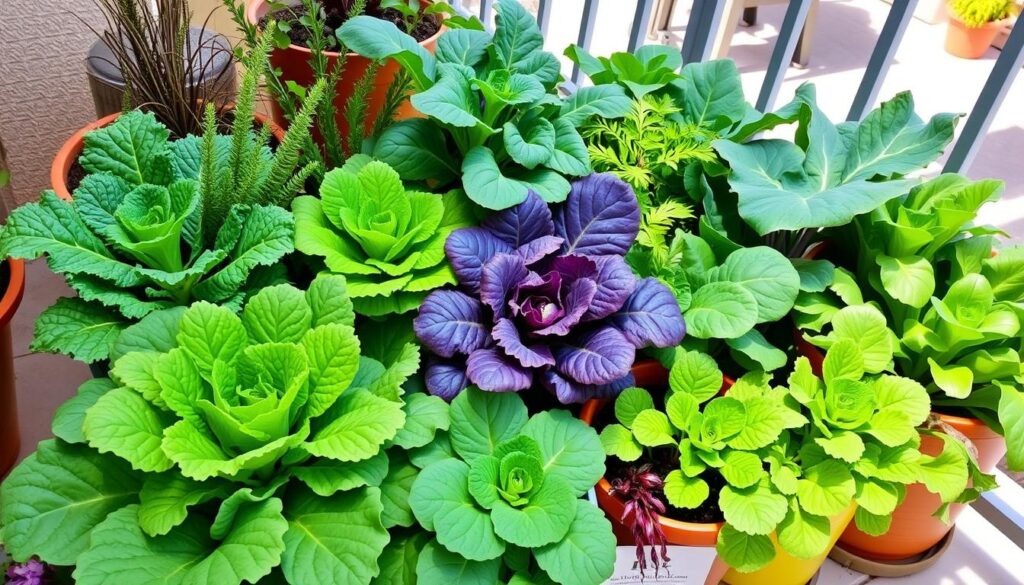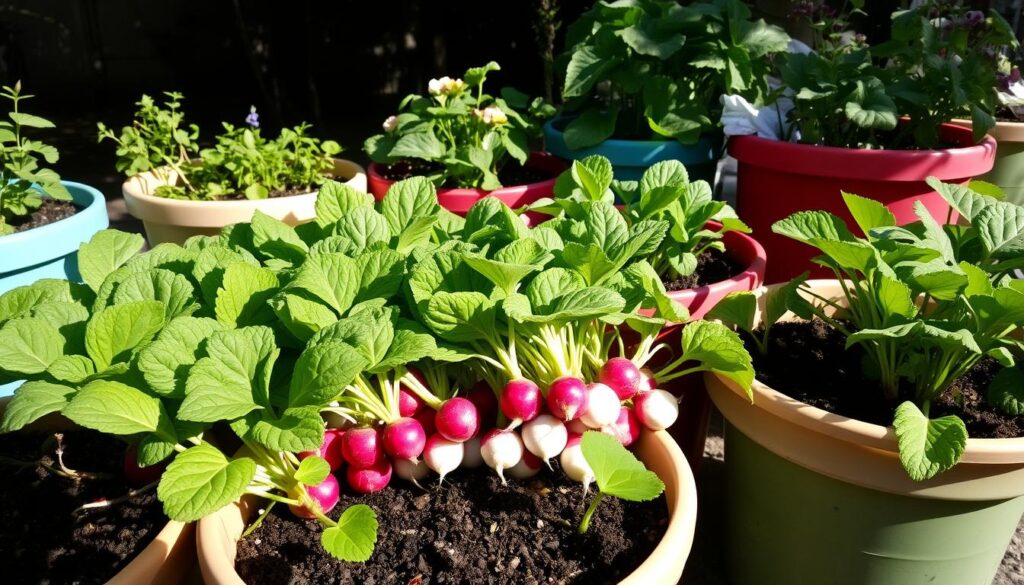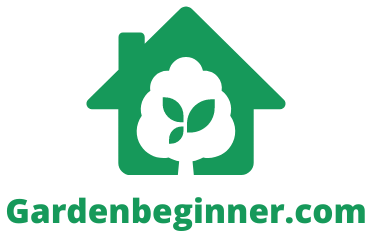In this article, I’ll show you the top 5 vegetables that do great in container gardens. You’ll learn how to grow fresh produce, even with little outdoor space. Whether you have a small balcony, patio, or just a few square feet, these veggies can make your space a garden paradise.
From classic tomatoes to leafy greens, I’ll help you choose, grow, and care for these container-friendly crops. You’ll see how easy it is to have a garden, even in the city.
Key Takeaways
- Discover the top 5 vegetables perfect for container gardening
- Learn how to grow fresh produce even in limited outdoor spaces
- Explore the benefits and versatility of container-friendly crops
- Gain insights into the cultivation and care of these vegetables
- Transform your urban or small-space garden into a bountiful oasis
Introduction to Container Gardening
Container gardening is a great way to grow veggies, even if you don’t have much space outside. By using container gardening, you can harvest fresh produce right in your hands.
Benefits of Growing Vegetables in Containers
One big plus of container gardening is controlling the soil. With a good potting mix, your veggies get the nutrients they need. Plus, it keeps pests and diseases away since the plants are in their own space.
Another benefit is how easy it is to take care of. You can move containers to get more sunlight and water them just right. This makes it simple to have a successful container size for vegetables garden.
Choosing the Right Containers
When picking containers, size and material matter a lot. The right container size for vegetables lets your plants grow well. Big containers are best for veggies like tomatoes, while small ones work for lettuce and radishes.
The container’s material is also important. Look for durability, insulation, and good drainage. These features help your garden succeed.
“Embracing the versatility of container gardening allows you to create a thriving vegetable oasis, even in the smallest of spaces.”
Tomatoes: The Versatile Container Crop
Tomatoes are a favorite in many gardens, and they do well in containers too. You can grow them on a small patio, balcony, or in a tiny garden. I’ll show you the best container tomato varieties and share tips on tomato care in containers. This way, you can get a big harvest, even with little space.
For container tomato varieties, cherry tomatoes like ‘Sungold’ and ‘Tiny Tim’ are great. They give lots of small, sweet tomatoes. For bigger tomatoes, try ‘Patio’ and ‘Tumbling Tom’. They grow well in containers and don’t take up much space.
| Tomato Variety | Type | Characteristics |
|---|---|---|
| Sungold | Cherry | Sweet, bite-sized fruit, prolific yields |
| Tiny Tim | Cherry | Compact, dwarf plant, perfect for containers |
| Patio | Determinate | Bush-type, great for small spaces |
| Tumbling Tom | Trailing | Cascades beautifully from hanging baskets |
For tomato care in containers, remember a few things. Use containers that are at least 5 gallons and fill them with good potting mix. Make sure your tomatoes get lots of sunlight, at least 6 hours a day. Water them regularly and use a balanced fertilizer to help them grow.
With the right container tomato varieties and care, you can have lots of juicy tomatoes. Even in small spaces, you can grow delicious tomatoes. Follow these tips to grow a successful crop that will make your taste buds happy and your gardening fun.
Leafy Greens: A Nutrient-Rich Addition
Container gardening opens up a world of possibilities. Leafy greens are a great addition to any small garden. They grow well in pots and planters, giving you fresh, tasty produce.
Types of Leafy Greens for Containers
There are many types of leafy greens for containers. Lettuce is a favorite, with its many colors and textures. Spinach and kale add nutrition and crunch. For a bit of bitterness, try arugula and endive.
Growing Tips for Leafy Greens
- Choose containers with good drainage and at least 6 inches deep for leafy greens for containers.
- Sow seeds or transplant seedlings 4-6 inches apart. This lets them spread their leaves.
- Give your container-friendly greens 6 hours of direct sunlight a day. Or, choose a spot with partial shade if it’s warm.
- Keep the soil moist but not waterlogged. This keeps your growing lettuce in pots healthy and vibrant.
- Regularly pick the outer leaves. This encourages new growth and keeps your greens fresh.

Follow these tips for a bountiful harvest of leafy greens for containers. They’ll add freshness and vitality to your small garden.
Peppers: Spice Up Your Container Garden
Peppers add a burst of flavor to any container garden. They come in many sizes, shapes, and heat levels. This makes them great for gardeners with small spaces. You can choose from mild, sweet bells to spicy habaneros, all of which grow well in containers.
Varieties of Peppers for Containers
Choosing the right pepper varieties for pots is key for container gardening. Here are some top picks for container-friendly peppers:
- Cayenne peppers: These long, thin peppers are perfect for hanging baskets or small pots. They have a moderate heat and produce lots of peppers.
- Mini bell peppers: These compact plants grow up to 12 inches tall. They come in many colors and taste sweet and mild.
- Banana peppers: These peppers grow well in containers and taste mild and slightly tangy.
- Jalapeño peppers: A favorite for container gardens, jalapeño plants are compact and produce many spicy peppers.
When growing peppers in containers, make sure they get enough sunlight and water. Use a potting mix that drains well to get a good harvest.
“Growing peppers in containers is a great way to add flavor and heat to your small-space garden. With the right pepper varieties for pots, you can enjoy a delicious crop of container-friendly peppers right from your own backyard.”
Carrots: A Root Vegetable Delight
Growing carrots in containers is fun and rewarding for gardeners. These container-friendly root vegetables do well in small spaces. They’re perfect for city living or small gardens. With the right tips, you can grow a lot of carrot varieties for pots.
Choosing the right container size is key for growing carrots. They need deep soil to grow long and healthy. Pick a pot that’s at least 12 inches deep and has good drainage. Also, make sure it’s wide enough for the carrots to spread out.
- For optimal results, select a container that is at least 12 inches deep.
- Ensure the pot has adequate drainage to prevent waterlogging.
- Choose a container that is wide enough to allow the carrots to spread out.
The soil mix is also very important for growing carrots in containers. Use a mix that drains well and is full of nutrients. It should also be free of big stones or debris. This mix will help your carrots grow strong and sweet.
“Carrots are a versatile and rewarding crop for container gardeners. With the right growing conditions, you can enjoy a bountiful harvest of these container-friendly root vegetables.”
By following these tips and picking the right carrot varieties for pots, you can grow your own carrots in containers. You’ll love adding them to your cooking.
Radishes: Quick and Easy to Grow
Radishes are a great pick for container gardens. They grow fast and are easy to care for. They give you a steady supply of crunchy, tasty roots all season long. Radishes are perfect for any small garden, whether you’re new to gardening or have lots of experience.
Varieties of Radishes for Containers
Some radish types grow better in containers than others. Here are some top picks:
- Cherry Belle: A classic, round radish with a bright red exterior and crisp, white interior.
- Sparkler: A bicolor variety with a vibrant red top and white bottom, offering a visually stunning addition to your garden.
- Daikon: An elongated, white Japanese-style radish that thrives in containers, producing large, juicy roots.
- French Breakfast: An oblong radish with a red top and white bottom, known for its mild, sweet flavor.
Radish Companion Planting
Radishes are great companions in your container garden. They help other veggies grow better and taste sweeter. They also keep pests away. Here are some good friends for radishes:
- Lettuce: Radishes help loosen the soil and shade the lettuce leaves.
- Carrots: Radishes break up the soil and tell you when to pick the carrots.
- Spinach: Radishes’ strong smell keeps aphids and other pests from spinach.
Using these planting tips, you can make a lively, diverse container garden. It will make the most of radishes in pots.

Top 5 Vegetables for Container Gardening
When it comes to the best vegetables for container gardening, a few stand out. These top container garden veggies are perfect for small spaces and beginners. They are easy to grow and rewarding.
- Tomatoes – These fruits are great in containers. They come in sizes from cherry to beefsteak.
- Leafy Greens – Lettuce, spinach, and kale are easy to grow. They’re also very nutritious.
- Peppers – You can grow sweet bell peppers or spicy chili peppers in containers. They add color and flavor to any garden.
- Carrots – Carrots can grow well in containers. They produce crunchy roots in a small space.
- Radishes – Radishes grow fast in containers. They offer a quick and fun harvest.
By choosing these best vegetables for container gardening, you’ll have a thriving garden. With a little care, these top container garden veggies will give you a big harvest. Enjoy your harvest from your backyard or patio.
Soil and Fertilizer Requirements
Getting the right soil and fertilizer is key for a successful container vegetable garden. Choose a high-quality potting mix for container gardening. It should have the right balance of drainage, aeration, and nutrient retention for your potting mix for container gardening vegetables.
Choosing the Right Potting Mix
Look for a mix with compost, peat moss, and vermiculite or perlite. Don’t use garden soil, as it can be too heavy for containers. Instead, pick a lightweight, well-draining mix for your potting mix for container gardening vegetables.
Fertilizing Your Container Vegetables
Regular fertilizing container vegetables is also important. Use a balanced, water-soluble fertilizer made for vegetables. Follow the instructions to make sure your plants get the nutrient needs for container plants they need.
- Apply the fertilizer every 2-4 weeks during the growing season
- Adjust the application rate based on the size of your containers and the specific needs of your vegetables
- Avoid over-fertilizing, as this can lead to excessive foliage growth at the expense of fruit or vegetable production
By choosing the right potting mix and fertilizing regularly, you can create the perfect soil and nutrient conditions for your container vegetable garden.
Watering and Sunlight Needs
Keeping the right moisture and sunlight is key for your container-grown veggies to grow well. I’ll show you how to water and light your plants right for a great garden.
Watering is crucial for your container garden. Since these plants have less soil, they dry out fast. Check the soil daily and water when the top inch is dry. Keep the soil moist but not too wet to avoid root rot.
Most veggies need 6 to 8 hours of direct sunlight a day. Pick a spot that gets lots of sunlight. If it’s not enough, move your containers or use extra lights to help your plants.



Leave a Reply